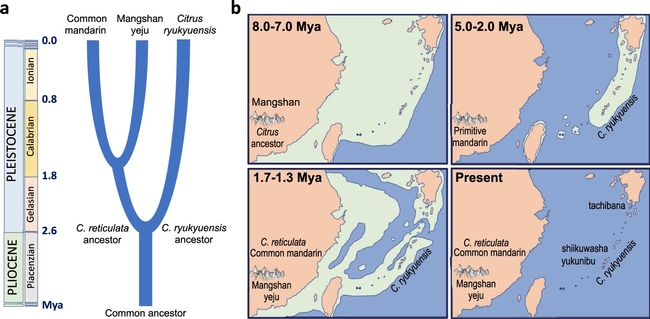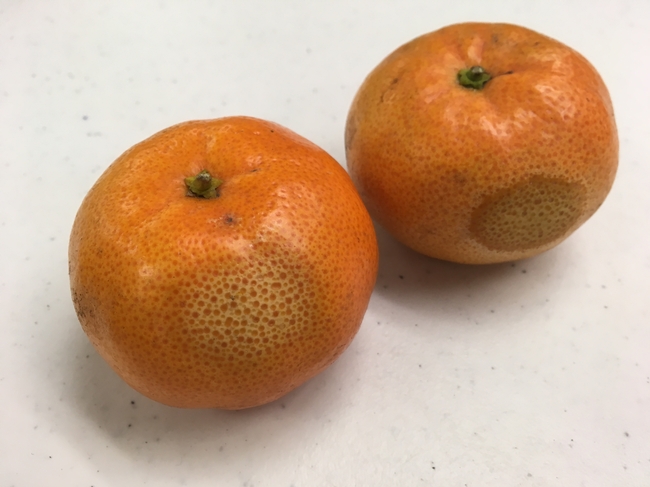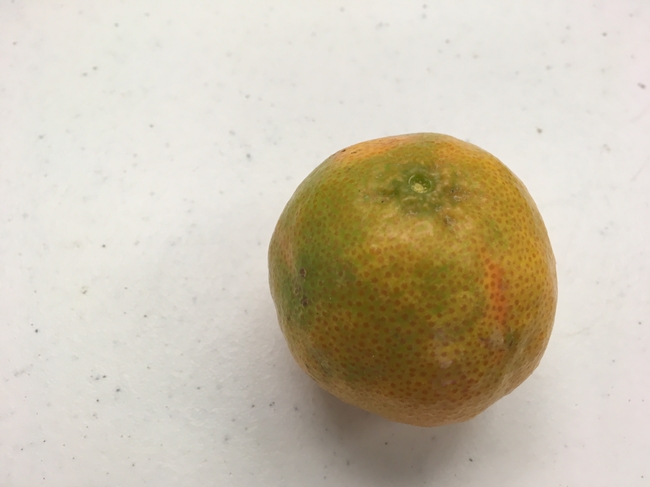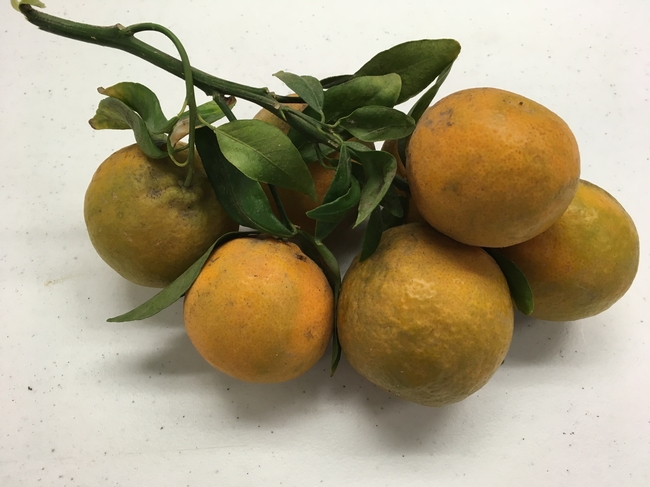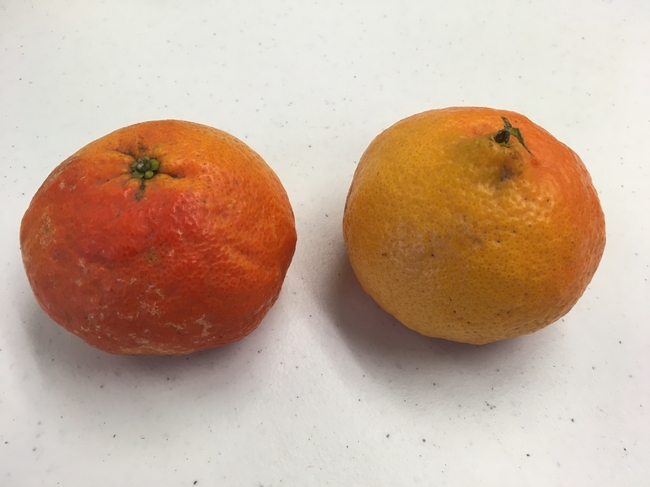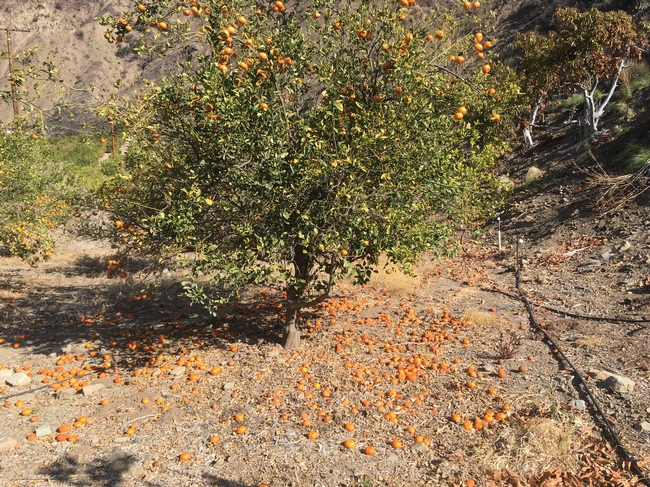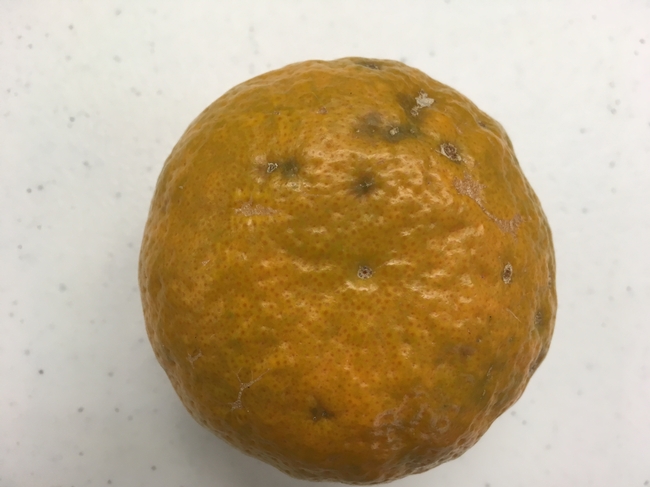
Posts Tagged: mandarins
Another Mandarin Species!!!
Tomomi Okubo
tomomi.okubo@oist.jp
Office: 81-989-823-447
- Citrus fruits from the mandarin family have important commercial value but how their diversity arose has been something of a mystery
- Researchers analyzed the genomes of the East Asian varieties and found a second center of diversity in the Ryukyu Islands along with the previously known center in the mountains of southern China
- They discovered a new citrus species native to Okinawa that arose about two million years ago when the Ryukyu archipelago became disconnected from mainland Asia
- Other citrus from Okinawa and mainland Japan, including shiikuwasha and tachibana, are hybrids of this newly discovered wild species with different mainland Asian varieties
- This research may have commercial implications and opens the potential to create additional hybrids with favorable traits
Citrus fruits from the mandarin family are popular throughout the world for their tasty and healthy characteristics. Within Japan, the tiny shiikuwasha and the ornamental tachibana are of special cultural and historical importance. However, the origin of these two varieties, and other East Asian citrus, was always something of a mystery, until now.
In a new study, published in Nature Communications, scientists from the Okinawa Institute of Science and Technology Graduate University (OIST), and collaborators from other institutes, analyzed 69 genomes from the East Asian mandarin family, alongside their mainland Asian relatives, to reveal a far-ranging story of isolation, long-distance travel, and hybridization.
The story starts in the Hunan Province of southern China, which is the center of wild mandarin diversity and the genetic source of most well-known mandarins. When the scientists re-analyzed previously published genomic data, they unexpectedly found that wild mandarins of this mountainous region are split into two subspecies.
"We found that one of these mandarin subspecies can produce offspring that are genetically identical to the mother," said Dr. Guohong Albert Wu, a research collaborator at the Lawrence Berkeley National Laboratory in California. "Like many other plants, wild citrus typically reproduces when the pollen of the father combines with the egg of the mother, mixing the genes from both parents in the seed. But we found a subspecies of wild mandarins from Mangshan, in southern China, where the seed contains an identical copy of the mother's DNA without any input from a father. So, the seed grows to be a clone of the mother tree."
Back in Okinawa, the researchers looked more carefully at a strange shiikuwasha-like citrus that produces small, acidic fruit and had been ignored by local farmers since it has little commercial value. To their surprise, they found that this strange citrus represented a previously undescribed species, which they named the Ryukyu mandarin or, more formally, Citrus ryukyuensis. And in contrast to the well-known shiikuwasha, which reproduces clonally (like the subspecies in Mangshan), the new species always reproduces sexually.
Remarkably, the researchers found that all shiikuwasha are hybrids of a very specific type--one parent is from the local Ryukyuan species and the other, from mainland Asia. Surprisingly, all shiikuwasha have the same mainland mandarin parent, meaning that all shiikuwasha are half-siblings.
They concluded that tens of thousands of years ago a mainland Asian mandarin was transported, either by people or by natural methods, to the land that would become the Ryukyu Islands. There it mated with the native Ryukyu citrus. The researchers traced the ancestry of this mainland Asian mandarin back to Mangshan, where it acquired its ability to reproduce asexually. This ability was passed on to its children.
Thus, all the shiikuwasha varieties found in Okinawa's markets today are descended from this mating, and reproduce asexually, allowing stable varieties like golden shiikuwasha to be propagated from generation to generation.
And what of tachibana and the other East Asian mandarin variations?
"They're all hybrids!" explained Dr. Chikatoshi Sugimoto, Postdoctoral Scholar in OIST's Molecular Genetics Unit. "The tachibana lineage also seems to have descended from the newly described Ryukyu species and another mandarin from China, but its birthplace was probably what is now mainland Japan."
Once they saw the genetic pattern in shiikuwasha and tachibana, the researchers also recognized another half-sibling family comprising various traditional Ryukyuan types--oto, kabuchii, tarogayo, and other unnamed citrus. This family, which the researchers called 'yukunibu' (sour citrus in the native Okinawan language), is much younger than shiikuwasha and tachibana. It arose when the famous kunenbo--also the father of satsuma mandarins--hybridized with the native Ryukyu mandarin. Kunenbo was brought to Okinawa from Indochina around 4-500 years ago by maritime trade. Like the mainland parents of shiikuwasha and tachibana, it was also able to clone itself by seeds, due to its distant Mangshan ancestry, and it passed this trait on to its children.
"It's fascinating to puzzle out the story of mandarin diversification and its relationship to the biogeography of the region," concluded Prof. Dan Rokhsar, Principal Investigator of OIST's Molecular Genetics Unit. "But it also could have commercial value. What other possibly hybrid types are there? Could we create new hybrids that are more resilient to disease or drought, or have other desirable characteristics? By looking into the past, we can create all sorts of possibilities for the future."
And the whole article: https://www.nature.com/articles/s41467-021-24653-0
Population divergence times of C. ryukyuensis (2.2–2.8 Mya) and two subspecies of mainland Asian mandarins (C. reticulata): common mandarin and mangshanyeju (1.4–1.7 Mya). Extant common mandarins are recent admixtures with both mangshanyeju and pummelos
source: https://www.nature.com/articles/s41467-021-24653-0#MOESM8
Hot Mandarins. What to Look forward to After a Fire
Mandarins, also known as “zipper skins” and “easy peelers” can have very fragile peels/skins/rinds/exocarp that make them easily subject to more damage than most oranges and lemons. Some are a bit tougher skinned than others, but some are so fragile that any rough handling often prevents them from going through conventional packing operations.
These skins were recently put to the test in the recent fires in Ojai. There was a mix of different varieties - ‘Pixie', ‘Gold Nugget', ‘W. Murcott', ‘Yosemite Gold', ‘Tahoe Gold' and others. Some of them were more sensitive than others, some were closer to the fire, all were affected by smoke to some degree. In Matilija Canyon where smoke was present for many more days than in the east of the Ojai Valley and possibly more ash, the trees have started flowering sooner. That might be temperature difference, either cooler or warmer, so it is hard to say how much effect the smoke has had versus, the ash and/or heat. Smoke has many different gasses in it, one of which is ethylene which is a naturally occurring ripening agent. Smoke not only has gasses, but it occludes the sun so less or more or altered light might have an effect on these fruit. It's not a controlled experiment, so some little scientist is going to have to come along and wriggle out these different effects. Whatever. Fire and smoke have an effect on mandarins as we have seen in other crops, such as cherimoya, avocados and other citrus.
Heat damage. Fruit facing the fire.
Ash effects on fruit coloring. Fruit was covered with ash for several days until rain washed it off. Might be a pH effect (ash is alkaline), temperature effect, uneven light radiation, or other…….
Same sort of uneven coloring, that actually looks like an ashy color, but the ash has washed off the cluster by rain
And here's something interesting where fruit facing the fire is much lighter colored than fruit facing away from the fire. Here are two pieces of fruit, one from the side directly facing the fire, and the other from the other side of the tree. The side of that fruit facing the fire was also lighter colored. So, it had an effect through the canopy (small tree). The canopy was otherwise intact, unaffected heat or flames.
Oh yeah, and there is the characteristic fruit drop from either the heat, smoke gases, water stress or ….
And then there's the fruit that looks like it had actual embers on the skin.
If the tree survives and keeps its green leaves, sometimes the fruit is affected in ways that don't appear for a while. The peel may be affected, but in many cases the fruit is just as sweet as it could be. It just looks terrible. That might even be a selling point. "Here have a wonderous piece of history that braved the horror of the Ojai fires."
Satsumas and Navels - Too Late?
There have been some complaints about satsuma mandarin fruit having problems. These are prone to a rind/skin/peel breakdown when the fruit is not picked promptly. It's not clear what the cause is - wet winter, warm winter - but it is less of a problem if the fruit is picked when it is mature. A lot of the time in southern California, satsumas will develop good flavor and sweetness, but for lack of cool weather, they don't turn bright orange, a hallmark of the fruit. So growers will leave the fruit on longer, hoping for color, but the fruit becomes over mature, and more susceptible to breakdown. This weakening of the peel then opens it up to infection by fungi, such as Alternaria. In warm winters, the peel matures more rapidly and is more susceptible. Early maturing varieties like ‘Okitsuwase' are especially prone to breakdown later in the season, since their rind matures earlier. They end up being a mess, as can be seen in the photo below.
Navels can have a similar problem in these winters with erratic rainfall. Common wisdom is you don't irrigate in the winter, right? Wrong. With no, low and widely spaced rain events, the tree roots dry out, and rewet with rain. Navels are building their sugar in the winter and they become suction balls for water as the sugar increases. The fruit will continue to grow as the tree takes up water. When the roots run out of water, and then are suddenly rewetted during this period, the fruit can suck up water so rapidly that the skin cant expand fast enough and will split. So this is what happens with uneven irrigation or rainfall this time of year. One of those abiotic problems in citrus.

satsuma rind breakdown

split navels
Citrus Grower Meeting Coming Soon
Every year growers get together to learn what is being done in the citrus research world that could affect their operations. This June, University of California and the Citrus Research Board are bringing some good talks to three different growing areas. All growers are invited, but RSVPs are appreciated.

CRB-GrowerSeminar-Flyer 2017
The Citrus Research Board and Growers
Funding of the Citrus Research Board is an investment in pertinent research that supports the industry, making the information accessible to all within the industry from pest control advisors to packing houses to farm managers and others within the industry. The goal is to get the research done and then make sure it is used. CRB represents both large and small growers throughout California.
CRB research programs are funded by grower assessments which attract both federal and state funding, funding which represents a third of the total budget. This funding is used to support such projects as, HLB-resistant citrus rootstocks; the development of effective, low-cost HLB early detection technologies to rapidly remove infected trees; improved biocontrol methods for specific insect control like Asian citrus psyllid, as well as others; pre-and post-harvest citrus research to maintain export markets, amongst many other research programs.
The Citrus Research Board also supports the Citrus Clonal Protection Program (CCPP) with the goal of insuring the safe introduction of citrus varieties, disease diagnosis and pathogen elimination of introduced varieties and the maintenance and distribution of introduced varieties. CCPP serves as the primary source of clean, disease-free budwood and new varieties from Florida. This work is a collaboration between the Citrus Nursery Board, the University of California and State and Federal Regulatory agencies. The CCCP has become a major hub of the National Clean Plant Network for Citrus, resulting in the collaboration with 10 citrus centers in nine states and territories with multimillion dollar funding in support of CCCP's operations.
CRB research supports the California Citrus Quality Council (CCQC) with the primary objective of ensuring that California citrus meets domestic and international phytosanitary, food safety, food additive and pesticide residue regulations. CCQC ensures that California citrus growers have access to export markets for their fresh citrus fruit. Exports represent a third of the California citrus grower profits.
CRB-funded research into the California citrus-breeding program has led to the development of the Tango mandarin, along with others. The core breeding program conducts yield trials throughout the state on all varietal types to give growers information on upcoming new varieties and rootstocks. There is ongoing work to incorporate molecular tools to expedite breeding efforts to find plant materials resistant to HLB.
Along with CRB funding for cutting-edge projects for pest and disease control strategies, the CRB-funded CORE IPM Program led by Beth Grafton-Cardwell has responded to citrus grower needs for modifying existing spray schedule to treat Asian citrus psyllid. The program evaluates rotational sprays at appropriate times to avoid pesticide resistance to ACP.
Finally, this CRB-packaged information has been extended to growers through programs, including: The California Citrus Conference, Post-Harvest Conference and Seminar, and Regional Grower Education Seminars. CRB-funded research is compiled in Citrograph Magazine, the only magazine dedicated solely to the California citrus industry.

citrus and mountains

